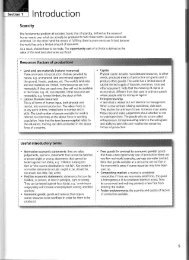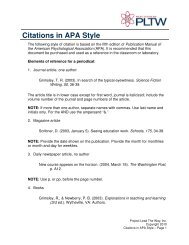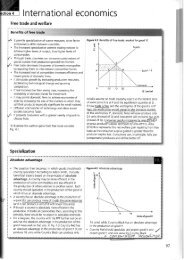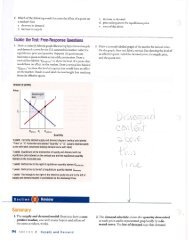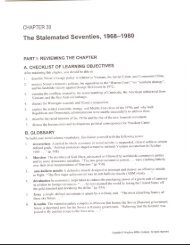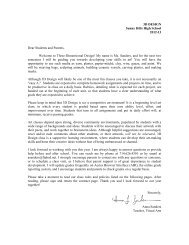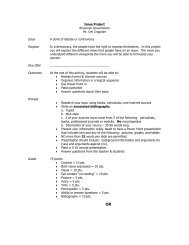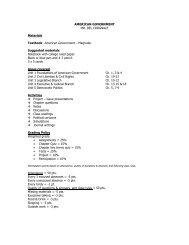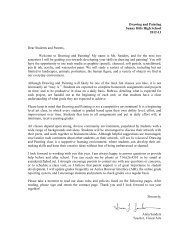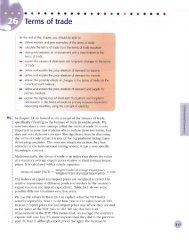AP Econ Module 30 Deficits Debt - Sunny Hills High School
AP Econ Module 30 Deficits Debt - Sunny Hills High School
AP Econ Module 30 Deficits Debt - Sunny Hills High School
Create successful ePaper yourself
Turn your PDF publications into a flip-book with our unique Google optimized e-Paper software.
<strong>Module</strong> <strong>30</strong> Long-run lmplications of Fiscal<br />
Policy: <strong>Deficits</strong> and the pubtic <strong>Debt</strong><br />
<strong>Module</strong> 31 Monetary Policy and the<br />
lnterest Rate<br />
<strong>Module</strong> 32 Money, output, and prices in the<br />
Long Run<br />
M0dule 33 Types of lnflation, Disinftation,<br />
and Deflation<br />
<strong>Module</strong> 34 lnflation and Unemployment The<br />
Phillips Curve<br />
Modulc 35 History and Alternative Views of<br />
Macroeconomics<br />
<strong>Module</strong> 36 The Modern Macroeconomic<br />
Consensus<br />
yi{5i FEn ts AstEEp!<br />
Jirn Crarner's Mad Monq is one of the most popular shows<br />
on CNBC, a cable TV network that specializes in business<br />
and financial news. Cramer, who mostly offers invescment<br />
advice, is knotrr for his sense of showmanship. But few<br />
viewers were prepared for his ourburst on August 3, 2007,<br />
when he began screaming about what he saw as inadequare<br />
action from the Federal Reserve:<br />
"Bernanke is being an academic! It is no time to be an<br />
academic. . . . He has no idea how bad it is out there,<br />
He has no idea! He has no ideat . . . and Bill poole? Has<br />
no idea what it's like out there! . . . They're nuts! They<br />
know nottringt . . . The Fed is asleep! Bill poole is a<br />
shame! He's shamefulll"<br />
\Y/ho are Bernanke and Bill<br />
Poole? In rhe prwious chapter we<br />
described the role ofthe Federal Reserve<br />
System, the U.S. central bank.<br />
At the time of CrameCs rirade, Ben<br />
Bernanke, a former Princeton professor<br />
of economics, was the chair<br />
of the Feds Board of Governors,<br />
and William Poole, also a former<br />
economics professor, was the presidenr<br />
ofthe Federal Reserve Bank of<br />
Sr. Louis. Both men, because of<br />
their positions, are members of the<br />
Federal Open Market Committeg<br />
which meets eight times a year to<br />
set monetary policy, In August<br />
2007 , Cratrrer was crying our for the<br />
Fed to change monetary poliry in<br />
order to address what he perceived<br />
to be a growing financial crisis.<br />
lnflation I<br />
Unemployment,<br />
and Stabillzalion<br />
Policies<br />
ln August zoo7, an agitated rlm Cramer demanded<br />
that the Fed do something to address the growlng<br />
financialcrisis.<br />
\14ry was Cramer screaming at the Federal Reserve<br />
rather than, say, the U.S. Treasury-or, for that matter, the<br />
president? The answer is that the Fed,s control of monetary<br />
policy makes it the first line ofresponse to macroeconomic<br />
difficulties-very much including the financial crisis<br />
that had Cramer so upset. Indeed, within a few weeks the<br />
Fed swung into action rvith a dramaric reversal ofits previous<br />
policies.<br />
In Section 4, we developed the aggregate demand<br />
and supply model and inroduced che use offiscal policy<br />
to stabilize the economy. In Section 5, we inrroduced<br />
money, banking, and the Federal Reserve System, and<br />
began to look at how monetary<br />
policy is used to stabilize the<br />
economy. In this section, we<br />
use the models introduced in<br />
Sections 4 and 5 to furrher<br />
develop our understanding of<br />
stabilizarion policies (both fiscal<br />
and monetary), including<br />
their long-run effects on the<br />
economy. In addition, we introduce<br />
the Phillips curve-a<br />
short-run trade-off between<br />
unexpected inflacion and unemployment-and<br />
investigate<br />
the role of expectations in rhe<br />
economy. We end the section<br />
with a brief summary of rhe<br />
history of macroeconomic<br />
thought and how the modern<br />
consensus view of stabilization<br />
policy has developed.<br />
295
(l(.(((q(ftillttiiiltrt: !'t 't:t .itliltlii!illt!iIit!ttitttlltitti:tttrr<br />
Why governments calculate<br />
the cyclically adjusted<br />
budget balance<br />
Why a large public debt may<br />
be a cause for concern<br />
Why implicit liabilities of the<br />
government are also a cause<br />
for concern<br />
<strong>Module</strong> @<br />
Long-run lmplications<br />
of Fiscal Policy: <strong>Deficits</strong><br />
and the Public <strong>Debt</strong><br />
In <strong>Module</strong> 20 we discussed how discretionary fiscal policy can be used to stabilize the<br />
economy in the shorr run. During a recession, an expansionary fiscal policy-raising<br />
govemment spending lowering taxes, or both-caa be used to shift the aggregate demand<br />
curve to the right. And when there are inflationary pressures in the ecorro-y, "<br />
contractionary fiscal policy-lowering governmenc spending, raising taxes, or both_<br />
can be used to shift rhe aggregate demand curve to the left. But how do these policies<br />
affect the economy over a longer period of time? In this module we will look at jome of<br />
the long-term effects offiscal policy, including budget balance, debt, and liabilities.<br />
The Budget Balance<br />
Headlines about the government's budget tend to focus onjust one poinc whether the<br />
government is running abudget surplus or abudget deficit and, in eirher case, how big.<br />
People usually think ofsurpluses as good: when the federal government ran a record.<br />
surplus in 2000, many people regarded it as a cause for celebrarion. Conversely, people<br />
usually think of deficits as bad: when the Congressional Budget Office p-jected a<br />
record federa-l deficit for 2009, many people regarded it as a cause for concem.<br />
How do surpluses and deficits fit into the analysis offiscal policy? Are deficits ever a<br />
good thing and surpluses a bad thing? To answer those questions, ler,s look at the<br />
causes and consequences ofsurpluses and deficim.<br />
The Budget Balance as a Measure of Fiscal policy<br />
\X4-rat do we mean by surpluses and deficits? The budget balance, which we have previously<br />
defined, is the difference between the government,s tax revenue and its spending<br />
both on goods and services ald on govemment transfers , in a, given year. fhat is, the<br />
budget ba.lance-savings by government-is defined by Equatiorr<strong>30</strong>-1:<br />
(<strong>30</strong>-l> sc"*-"",= T - G - TR<br />
296 section 6 lnflation, Unemployment, and Stabitization policies
where Iis the yalue of ta-r revenues, G is government purchases ofgoods and services,<br />
and TR is the value ofgovernment transfers. A budgeisurplus is a p-ositive budget bal_<br />
ance, and a budget deficit is a negative budget balance.<br />
Other things equal, expa-nsionary fiscal policies-increased governmenr purchases of<br />
goods and services, higher government transfers, or lower ta-xei_reduce the budget bal_<br />
ance forth-at year. Thar is, expansionary fisca.l policies ma,ke a bud.get surplus smal'ier or a<br />
budget deficit bigger. Conversely, contracrionary fiscal policies-r"d,lced govemment pur_<br />
chases of goods and services, lower government tr.rr"f"rr, o, higher ta-res_increase the<br />
budget balance for that year, making a budget surplus bigger or a budget deficit smaller.<br />
You might think this means rhat changes in the budger balance can be used to<br />
measure fiscal policy. ln fact, economists often do just rhat: rhey use changes in rhe<br />
budget balance as a "quick-and-dirry'' way to assess whether currenr fiscal p;liry is expansionary<br />
or contracrionary. But they always keep in mind rwo reasons this quick_<br />
and-dirry approach is sometimes misleading:<br />
r Two differenr changes in fiscal policy that have equal-size effects on the budget bal_<br />
ance may have quite unequal effects on the economy. As we have already seen,<br />
changes in government purchases ofgoods and services have a larger effect on real<br />
GDP than equal-size changes in taxes and government rransfers.<br />
r Often, changes in the budget balance are rhemselves the result, not the cause, of<br />
flucruarions in the econom).<br />
To understand the second point, we need to examine the effects ofthe business cycle<br />
on the budger.<br />
The Business Cycle and the Cyclically Adjusted<br />
Budget Balance<br />
Historically, there has been a strong relationship between the federal government,s<br />
budget balance and the business cycle. The budget tends to move into deficit when rhe<br />
economy experiences a recession, but deficits tend to get smaller or even rurn inro sur_<br />
pluses when the economy is expanding. Figure <strong>30</strong>.1 shows the federal budget deficit as<br />
a percentage ofGDP from 1970 to 2009. Shaded areas indicate recessions; unshaded<br />
areas indicate expansions. As you can see, the federal budget deficir increased around<br />
the time ofeach recession and usually declined during expansions. In fact, in rhe late<br />
The U.S. Federal<br />
Budget Deficit and<br />
the Business Cycle<br />
The budget deficitas a percen!<br />
age of GDP tends to rise during<br />
recessions {indicated by shaded<br />
areas) and fall during expansions.<br />
Sourcer Blreau of <strong>Econ</strong>omic Analysis;<br />
Nalional Burcau of <strong>Econ</strong>omic Research.<br />
Budget deficit<br />
(percent of GDP)<br />
10%<br />
8<br />
6<br />
4<br />
2<br />
0<br />
-2<br />
^s<br />
sp<br />
gr"<br />
9tr<br />
g""<br />
gr"<br />
,"""<br />
t"s """"<br />
Year<br />
m0dule <strong>30</strong> Long-run lmplications of Fiscal Policy: Def ic its and the Public <strong>Debt</strong> 297
The cyclically adlustod budg8l balanc€<br />
is an estmate of what the budget balance<br />
would be ff real GDP were exactly oqual to<br />
potential output.<br />
The U.S. Federal<br />
Budget Deficit and<br />
the Unemployment<br />
Rate<br />
Itrere is a clos€ mlationship be-<br />
twssn fiB budoet balance and<br />
the business cycle: a rscession<br />
moves the budget balance b-<br />
ward dsficlt, but an expansion<br />
moves it toward surplus. Hsre,<br />
the unemployment rate ssrves<br />
as an indicabr of the business<br />
cycle, and we should expect b<br />
see a higher unsmployment<br />
rate a$ociat8d wilh a higher<br />
budget deficit. lhls ls confirmed<br />
by the figure:$e budget deficit<br />
as a percenhge of GDP moves<br />
closoly in tandem wih the un-<br />
employment rate,<br />
Sot rdr. Bumau of <strong>Econ</strong>omic Analysis;<br />
Bu.eau of lalor Shtslics.<br />
stages ofthe long expansion from 1991 to 2000, the deficir actually becarne negative_<br />
the budget deficir became a budget surplus.<br />
The reladonship between the business cycle and the bud.get balance is even clearer if<br />
we cornpare the budget deficit as a percentage ofGDp with the unemplo;,tnent rate, as<br />
we do in Figure.<strong>30</strong>.2. The budget deficic almost always rises when the unemployment<br />
rate rises and falls when the unemployment rate fa.lls.<br />
Is this relationship between the business cycle and the budget balance evidence that<br />
policy makers engage in discretionary fiscal poliry? Not necelsarily. It is largely auromatic<br />
stabilizers chat drive the relationship shown in Figure <strong>30</strong>.2. As we learned in the<br />
discussion of automatic stabilizers in <strong>Module</strong> 21, government rax revenue tend.s to rise<br />
and some govemment rransfers, like unemployrnent benefit payments, tend to fall<br />
when the economy expands. Conversely, govemment tax revenue tends to fall and<br />
some government transfers tend to rise when rhe economy contracm, So the budget<br />
tends to_move toward surplus during expansions and toward deficit during recessiJns<br />
even without any deliberate action on rhe part of policy makers.<br />
assessing<br />
_ budget policy, it's<br />
_In often useful ro separare movements in the budget<br />
balance due to the business cycle from movements due to discretionary fiscal policy<br />
changes. The former are affected by automatic stabilizers and the latter by deliberate<br />
changes in government purchases, govemment transfers, or taxes, ICs imporcant co realize<br />
that business-cycle effects on the budget balance are temporary: both recessionary<br />
gaps (in which real GDP is below potential outpur) and inflationary gaps (in which real<br />
G,DP is above porential outpur) tend to be eliminared in the long run. Removing their<br />
effects on the budget bilance sheds light on whether the govimmenCs taxing and<br />
spending policies are sustainable in the long run. In other words, do the government,s<br />
tax policies feld enough revenue to fund its spending in the long run? As we,ll learn<br />
shortly, this is a fundamentally more important question rhan whether the government<br />
runs a budget surplus or deficit in the current year,<br />
To separate the effect of the business cycle from the effects of orher factors, many<br />
governments produce an estimate of what the budget ba.lance would be if there were<br />
neither a recessionary nor an inflationary gap. The cyclically adjusted budget balance<br />
Budget<br />
d€ficit<br />
(percent<br />
of cDP)<br />
1090<br />
8<br />
6<br />
4<br />
2<br />
0<br />
-4<br />
^S<br />
^,9'<br />
298 section 6 lnflation, Unemptoyment, and Stabitization policies<br />
^b<br />
r9'<br />
"+'<br />
gse<br />
g.'<br />
g""<br />
.L! ^ss<br />
rts t'""<br />
Year<br />
Unempl.oyment<br />
rate<br />
(percent)<br />
r20t"<br />
10<br />
8<br />
6<br />
4<br />
2
The Actual Budget<br />
Deficit Versus the<br />
Cyclically Adjusted<br />
Budget Deficit<br />
the cyclically adjusted budget deficit is<br />
an estimate of what fie budget deticit<br />
would be lf the economy were at po-<br />
tential 0utput. lt fluctuates less than<br />
the actual budget deficit, because<br />
years ot large budqet deficits also tend<br />
to be yearc when the economy has a<br />
large recessionary qap.<br />
&urcei Co0gre€6ional Eudoet off ice,<br />
is an estimate ofwhat the budget balance would be ifreal GDP were exactly equal to potential<br />
output. It takes into account the qxtra tax revenue the government would collect<br />
and the transfers it would save ifa recessionary gap were eliminated-or the revenue the<br />
government would lose and the exrra transfers it would make if an inflationary gap<br />
were eliminated.<br />
Figure <strong>30</strong>.3 shows the artual budget deficit and the Congressional Budget Office estimate<br />
of the cyclically adjusted budget deficit, both as a percentage of GDP, since<br />
1970. As you can see, the gtclically adjusted budget deficit doesn't fluctuare as much as<br />
the actual budget deficit. In parcicular, large actual deficits, such as those of 1975 and<br />
1983, are usually caused in part by a depressed economy.<br />
Should the Budget Be Balanced? {.f,'<br />
Persistent budget deficits can cause problems for both the govemment $j;rfi<br />
and the econoiry. Yet politicians are alway" t"-pted ro rui deficirs be- p.;,\<br />
cause this allows them to cater to vorers by cutting taxes without cut- \t'1$<br />
ting spending or by increasing spending without i-rcr.""ing tares. A, " Y<br />
result, there are occasional attempts by policy makers to forie fiscal disci- F-rll<br />
iITg il[#tf,1:f;'#x;il11; ;:u::u:*.ru* ":i;; H<br />
stated as a requirement that the budget be "balanced"-that revenues $l/<br />
at least equal spending each fiscal year. Would it be a good idea to re<br />
quire a bianced budgit annualJy? gf.t<br />
Most economists don't think so. They believe that the governme". Ii'!@ilj<br />
should only balance its budget on average-that ir should be allowed to fifi<br />
run deficits in bad years, offset by surpluses in good years. They dont be- fi lt[<br />
lieve the government should be forced to run a balanced budget er.,ery \2<br />
jearbecause this would undermine the role oftaxes and transfers as automatic<br />
stabilizers. As we learned earlier, the tendency oftax revenue to<br />
fal and transfers to rise when the economy contracts helps to limit<br />
the size ofrecessions. Bur falling cax revenue and rising transfer pay- '1<br />
ments push the budget toward deficit. If constrained by a balancedbudget<br />
rule, the govemmenr would have ro respond to this deficit wirh<br />
contractionary fiscal policies that would tend to deepen a recession.<br />
module 3O Long-run lmplications of Fiscal Policy: <strong>Deficits</strong> and the Public <strong>Debt</strong> 299<br />
5<br />
E
A liscal yoat runs from october 1 to<br />
September <strong>30</strong> and is labeled according to the<br />
calendaryear in which it ends.<br />
Public debt is government debt held by<br />
indivlduals and institutions outside the<br />
govemment.<br />
<strong>30</strong>0 section 6<br />
Nonetheless, policy makers concerned about excessive deficits sometimes<br />
feel that rigid rules prohibicing-or at leasr setting an upper limit on_deficits<br />
afe necessary.<br />
Long-Run lmplications of Fiscal policy<br />
During the 1990s, the Japanese governmenr engaged in massive deficit spend.ing in an<br />
effort. to increase aggregate demand. That policy was partly successful altiough<br />
Japan's economy was sluggish during the l99Os, it avoided a s"r,e.e slump comparabie<br />
ro what happened to many countries in the 19<strong>30</strong>s. yet the fact rhatJapan was running<br />
large deficits year after year made many observers uneasy, as Japan,s d.ebt_the accumui<br />
lationofpast deficits, net ofsurpluses-climbed to alarmingievels. Now that we under_<br />
stand how governmenr surpluses and deficits happen, leCi take a closer look at their<br />
long-run effects on the economy.<br />
<strong>Deficits</strong>, Surpluses, and <strong>Debt</strong><br />
'rVhen a family spends more than it earns over rhe cours e of tyear, it has to raise the<br />
exrra funds either by selling assets or by borrowing. And ifa family borrows year after<br />
year, ir will evennrally end up with a lot of debt.<br />
The same is true for governments. With a few exceptions, governments don,t raise<br />
large sums by selling assets such as national parkland. Instead, when a governmenr<br />
spends more tharr the tax revenue it receives-when it runs a budget deficit_it almost<br />
always borrows the extra funds, And governmenrs that run persiitent budget deficits<br />
end up with substantial debts.<br />
, To interprer the numbers thar follow, you need ro know a slightly peculiar feature<br />
of federal government accounting. For historical reasons, the U.S. government does<br />
not keep the books by calendar years. Instead, budget totals are kepi by fiscal years,<br />
which run from October 1 to September <strong>30</strong> and are labeled by the calendar year in<br />
which they end. For example, fiscal2009 began on October 1,200g, and ended on September<br />
<strong>30</strong>,2009.<br />
At the end of fisca.l 2009, the U.S. federal governmenr had total debt equal to $12<br />
trillion. However, pan ofrhat debr represented special accounting rules spe.i$ring that<br />
the federal government as a whole owes funds to certain gor,"--"rra p-gr*.,<br />
cially Social Security. We,ll expla.in those rules shortly. For now, however, leCs focus<br />
"rp"_<br />
on<br />
public debe government debt held by individuals and institurions outside the government.<br />
At the end of fiscal 2009, the federal governmenCs public debt was..only', $7.6<br />
trillion, or 53% ofGDP If we include the debts of state and local governments, total<br />
government public debt was approximately 69% ofGDP.<br />
U.S. federal government public debt at the end offiscal 2009 was larger than ir was<br />
at the end offiscal 2008 because the federal government ran a budget deficir during fiscal<br />
2OO9. A government that runs persistent budget deficits will experience a rising<br />
level ofdebt.'&/hy is this a problem?<br />
Problems Posed by Rising Government <strong>Debt</strong><br />
There are two realsons to be concerned when a government runs persistent budget<br />
deficits. We described one reason previously: when the government borrows funds in<br />
the financial markets, it is cornpeting wirh firms that plan to borrow funds for investment<br />
spending. As a result, the government's borrowing may ,.crowd out', private investment<br />
spending, increasing interest rates and reducing the economy's long-run rate<br />
ofgrowth.<br />
The second reason: today's deficits, by increasing the govemmenCs debt, place financial<br />
pressure on future budgets. The impact ofcurrent deficits on future budgets is<br />
straightforward. Like individuals, govemments musr pay their bills, including inierest<br />
payments on their accumulated debr. V/hen a governmenr is deeply in debg those in_<br />
terest payments can be substaltial. In fiscal 2009, the U.S. federal government paid<br />
lnflalion, Unemployment, and Stabilization policies
2.7yo of GDP-9383 billion-in interest on its debt. And although this is a relatively<br />
large fraction ofGDP, other countries p ay even greater frartions oftheir GDp to service<br />
their debt. For example, in 2009, Greece paid interest ofabout S.4% ofcDp.<br />
Other things equal, a govemment paying Large sums in interest must raise more revenue<br />
from taxes or spend less than it would otherwise be able to afford-or it must borrow<br />
even more to cover the gap. And a government that borrows to pay interesr on irs<br />
outstanding debt pushes itselfeven deeper into debt. This process can evenrually push<br />
a govemment to the point at which lenders question its abfiry to repay. Like consumers<br />
who have maxed out their credit cards, the govemnent will find that lenders<br />
are unwilling to lend any more funds. The result can be thar rhe government defaults<br />
on its debt-it srops pafng what it owes. Default is often followed by deep financial<br />
and economic turmoil.<br />
The idea of a government defaulring sounds far-fetched,<br />
but it is not impossible. In the 1990s, Argentina, a relatively<br />
high-income developing country was widely praised for its<br />
econornic policies-and it was able to borrow large sums from<br />
foreign lenders. By 2001, however, Argentina's interest payments<br />
were spiraling out ofcontrol and the country stopped<br />
paying the sums that were due. Default creates havoc in a<br />
country's financial markets and badly shakes public confidence<br />
in both the government and the economy, Argentina's<br />
debt default was accompaaied by a crisis in the country's<br />
banking system and a very severe recession. And even if a<br />
highly indebted govemment avoids default, a heavy debt burden<br />
typically forces it to slash spending or raise taxes, politically<br />
unpopular measures that can also damage the econorny.<br />
One question some people ask is: can't a govemment that has t(ouble borrowing just<br />
print money to pay irs bills? Yes, it can, but this leads to another problem: inflation. In<br />
fart, budget problems are the main cause ofvery severe inflacion, as we'Il see later. The<br />
point for now is that governments do not want to find themselves in a position where<br />
the choice is between defaulting on their debts and inflating those debts away.<br />
Concerns about the long-run effects of deficits need not rule out the use of fiscal<br />
polici' to stimulate the economy when it is depressed. However, these concems do<br />
mean that governments should try to offset budget deficits in bad years with budget<br />
surpluses in good years. In other words, governments should run a budget that is approxirnately<br />
balanced over time. Have they actually done so?<br />
<strong>Deficits</strong> and <strong>Debt</strong> in Practice<br />
Figure <strong>30</strong>.4 on the next page shows how the U.S. federal govemmenc's budget deficit<br />
and its debt have evolved since 1940. Panel (a) shows the federal deficir as a percentage<br />
of GDP. As you can see, the federal govemment ran huge deficits during World W'ar II.<br />
It briefly ran surpluses after the war, but it has normally run deficits ever since, especially<br />
after 1980. This seems inconsistent with the advice that governments should offset<br />
deficits in bad times with surpluses in good times.<br />
However, panel (b) ofFigure <strong>30</strong>.4 shows that these deficits have not led to runaway<br />
debt. To assess the ability of governments to pay their debr, we often use the debt-<br />
GDP ratio, the governmenCs debt as a percentage ofGDP. W'e use this measure, raaher<br />
than simply looking at the size ofthe debt because GDP, which measures the size ofthe<br />
economy as a whole, is a good indicator oFthe potential taxes the government cal collect.<br />
Ifthe governmenCs debt grows more slowly than GDP, the burden ofpafng that<br />
debt is actua-lly fa-lling compared with the governmenCs porential rax revenue.<br />
What we see from panel (b) is that although the federal debt has grown in almost<br />
eyery year, the debt-cDP ratio fell for <strong>30</strong> years after the end of World War II. This<br />
shows that the debt-GDP ratio can fall, even when debr is rising, as long as GDP grows<br />
faster than debt. Growth and inflation sometimes allow a govemment that runs persistent<br />
budget deficits to nevertheless have a declining debt-GDP rado.<br />
m o d u le 3 0 Long-run lmplications of Fiscal Policy: <strong>Deficits</strong><br />
Lautario Palacios, T, holds a<br />
sign that calls forpotiticlans to<br />
stop robblng, durlng a January 9,<br />
2oo2 demonstlatlon ln Buenos<br />
Aires, Argentina.<br />
fte debt-G0P ratio is he government's<br />
debt as a percentage of GDP,<br />
and the Public Dsbl <strong>30</strong>1
Budget deficit<br />
(percent<br />
of GDP)<br />
400to<br />
<strong>30</strong><br />
20<br />
10<br />
0<br />
Budget deficit<br />
(percent of GDP)<br />
U.S. Federal <strong>Deficits</strong> and <strong>Debt</strong><br />
(a) The U.S, F€derat Eudget Deficit Since 1940 (b) The U.S. Pubtlc <strong>Debt</strong>-GDp Ratto Since 1940<br />
-10<br />
gtt tr"' r9' g$s g"" ,.."<br />
""o<br />
""N<br />
720t"<br />
10<br />
8<br />
6<br />
4<br />
2<br />
0<br />
-2<br />
-4<br />
Year<br />
Panel (a) shows lh8 U.S. tederal budget deflclt as a percenlage<br />
0l GDP slnco 1940. The U.S. govemment lan huge deflclts<br />
during World War ll and has usually run smaller dellcits evor<br />
8ince. Pan€l (b) sho'rr,s lie U.S. debt-GDp raflo. C0mparlno<br />
pansls (a) and (b), you can see that in many y€als the<br />
Public<br />
debt (p€rcent<br />
of cDP)<br />
720%<br />
100<br />
80<br />
60<br />
40<br />
20<br />
g""<br />
ges<br />
9a<br />
^s<br />
r9'<br />
""-'<br />
^fr+<br />
""at "a""<br />
Year<br />
dett-GDP mtio has declined in splts ol government deticits.<br />
This seemino paradox r€llects he tact that the dsbt+Dp raflo<br />
can fall, svsn when debt is rising, as long as GDp grows laster<br />
than debt.<br />
s4ncai Olfico o[ tthnagsmont ad &JdO6t<br />
Still,-a government that runs persiscent krge d,eficits will have a rising debt-GDp<br />
:*1o .!"1 debr grows faster than GDp. panel (a) of Figure <strong>30</strong>.5 shows Japan,s<br />
budget deficir as a percentage ofGDp, and panel (b) showsla,pan,s debt-CDi ratio,<br />
both since 1990. As we have already mentioned Japan began running large deficits<br />
in the early 1990s, a by-product of its efforc to prop up aggregare demand with<br />
Japanese <strong>Deficits</strong> and <strong>Debt</strong><br />
-(a) the Japanese Budget Deffcit Since 1990 (b) The Japanese <strong>Debt</strong>-GDP Ratio Since 1990<br />
,"+ p* ++ otr BS,.." ".& "".""."",si.."<br />
Year<br />
Panel (a) shows the budget deficit of Japan as a percent ol GDp<br />
sinca 1990 and pan6l (b) shows lb debrcDp ralio. Tle large<br />
deficib tEt tie Japaness govemment beoan running in ftg<br />
eady 1990s havo led b a rapid rise in ib debt+Dp rado as debt<br />
Pubtic<br />
debt (percent<br />
of GDP)<br />
100%<br />
,80<br />
60<br />
40<br />
20<br />
""+ B* ""+ ,"S BS ,s" ,.e ".." ".." "".i.o<br />
Year<br />
has 0rown more quickly lhan GDP n s ha8 l€d some amlysb<br />
t0 express concern aDout tE long-run tiscal heaffi of fie<br />
Japanese economy.<br />
Sarfue. hbm.tlrnal Monobry Fmd.<br />
<strong>30</strong>2 section 6 lnflation, Unemployment, and Stabilization policies
What Happened to the <strong>Debt</strong> from World War ll?<br />
As you can see from Fiqure <strong>30</strong>.4, the govern- dipped slightly in the next few years, as the cause the debt-cDp ratio had ta en by more<br />
ment paid for World War ll by borrowing on a United states ran postwar budget su rpluses, but than half. The reason? Vigorous economic<br />
huge scale. By the war's end, the public debt the government budget went back into deficit in growth, plus mild inllation, had led to a rapid<br />
was more than 100% of Goq and many people 1950 with the start of the Korean War. By 1962, rise in GDp The experience was a clear lesson<br />
worried about how it could ever be paid off. the public debt was back up to $248 billlon. in the pecutiar fact that modern governments<br />
The truth is that it never was paid off, ln 1946, But by that time nobody was worried about can run deficits forever, as long as they aren't<br />
the public debt was $242 billion; that number the tiscal health ol the U.S. government be- too large.<br />
government spending. This has led to a rapid rise in the debr GDt) ratio. For this<br />
reason, some economic analysts are concerned about the long-run fiscal health of<br />
theJapanese economy.<br />
lmplicit Liabilities<br />
Looking at Figure <strong>30</strong>.4, you might be rempted ro conclude that the U.S. federal<br />
budget is in fairly decent shape: the return to budger deficits after 2001, and largebut<br />
temporary increases in government spending in response ro the recession that<br />
began in 2007, caused the debt GDP rario to rise a bit, but rhar rario is still low compared<br />
with both historical experience and some other wealrhy countries. In fact, however,<br />
experts on long-run budget issues view the situation of rhe United States (and<br />
other countries with high public debt, such as Japan and Greece) with alarm. The reason<br />
is the problem of irnplicit liabilities. Implicit liabilities are spending promises<br />
made by governments rhar are effectively a debt despite the fact rhar they are not included<br />
in the usual debt statistics.<br />
The largest implicit liabilities of the U.S. governmenr arise From rwo rransfer<br />
programs that principally benefir older Americans: Social Security and Medicare.<br />
The third-largest implicit liability, Medicaid, benefits low-income families. In each<br />
ofthese cases, the government has promised ro provide transfer payments ro future<br />
as well as current beneficiaries. So these programs represent a future debt that<br />
must be honored, even though the debt does not currently show up in rhe usual<br />
statistics. Together, these rhree programs currently accounr for almost 407o of federal<br />
spending.<br />
The implicit liabilities created by these transfer programs worry fiscal experts.<br />
Figure <strong>30</strong>.6 on the next page shows why. It shows actual spending on Social Security<br />
and on Medicare and Medicaid as percenrages of GDP from 1962 to 2008,<br />
with Congressional Budget Office projections of spending througl.r 2083. Ac,<br />
cording to these projections, spending on Social Security will rise substantially<br />
over the next few decades and spending on the rwo health care programs will<br />
soar. Why?<br />
In the case ofSocial Securitl the answer is demography. Social Securiry is a "pay-asyou-go"<br />
system: current workers pay payroll taxes that fund the benefits ofcurrent retirees.<br />
So demography-specifically, the ratio of rhe number of retirees drawing<br />
benefits to the number ofworkers paying into Social Securiry has a major impacc on<br />
Social Security's finances. There was a huge surge in the U,S. birth rate between 1946<br />
and 1964, the years of the baby boom. Baby boomers are currently of working agewhich<br />
means they are paying taxes, not collecting benefits. As the baby boomers retire,<br />
they will stop earning income that is taxed and start collecting benefits. As a result, the<br />
ratio ofretirees receiving benefits to workers paying inro tl.re Social Securiry sysreIll will<br />
rise. In 2008, there were 31 retirees receiving benefits for every 100 workers paying inro<br />
lnplicit liabilities ar€ spendinq pr0mises<br />
made by governments ihat are efiectively a<br />
debt desp te the fact that they are fot<br />
inc uded n the uslaldebt statstcs.<br />
module <strong>30</strong> Long-run lmplications of Fiscal Policy; <strong>Deficits</strong> and the Public <strong>Debt</strong> <strong>30</strong>3
Future Demands on<br />
the Federal Budget<br />
Il s flgure shows Congressional<br />
Budget office projsc-<br />
tions of spending on soclal<br />
insurance Uoorams as a share<br />
of GDP hrtiy as a resuft of an<br />
aging populadon, but mainty<br />
because ot rislng hsalth care<br />
cos{s, tiese programs ars ex-<br />
pected to become much more<br />
expensiw over time, posing<br />
ffoblems lor the lederal<br />
budgst<br />
&urDa Congr€ssional Budget offico.<br />
f Medicorc and Medicoid<br />
J Social Secuity<br />
the system. By 20<strong>30</strong>, according to rhe Social Securiry Administration, that number will<br />
rise to 46; by 2050, it will rise to 48; and by 2080 that number will be 51. This will raise<br />
benefit payments relarive to rhe size ofrhe economy.<br />
of the baby boomers, by<br />
.The-aging itsef poses only a moderately sized long-run fis_<br />
cal problen. The projected rise in Medicare and Medicaid spending is a much more serious<br />
concern. The main story behind projections of higher Me&care and Medicaid<br />
spending is the long-run tendency of health care spending to rise fasrer than overall<br />
spending both for government-funded and for private-funded health care.<br />
. To some extent, the implicit liabilities ofthe U.S. government are already reflected<br />
in debt statistics. We mentioned eadier that the govirnment had a total debt of $12<br />
trillion at the end offiscal 2009, but that only $7.6 trillion ofthat toral was owed to the<br />
public The main explanation for thar discrepaacy is that both Social Security and part<br />
ofMedicare (the hospital insurance program) are suppo rred.by dedirated. taxis: theii expenses<br />
are paid out ofspecial taxes on wages, At times, these dedicated taxes yield more<br />
revenue than is needed to pay current benefits. In particular, since rhe mid-lggOs the<br />
Social Security system has been taking in more revenue tharr it currently needs in ord.er<br />
to prepare for the retirement ofthe baby boomers. This surplus in the Social Security<br />
system has been used to accurnulate a Social Secait! trustfaf which was g2.5 trillion at<br />
the end offiscal2009.<br />
The rnoney in the trust fund is held in the form of U.S. government bonds, which<br />
are included in the $12 trillion in rotal debt. you could say that rhere,s somerhing<br />
funny about counting bonds in the Social Security trust fund as p".t of gorr"rrrrn"rri<br />
debt. After all, these bonds are owed by one part of the govemment (the govemment<br />
outside the Social Securiry system) to another part ofrhe government (the Social Security<br />
system irsel$. But the debt corresponds to a real if implicit, liability: promises by<br />
the govemment to pay future retirement benefits. So many economists argue that the<br />
gross debt of$12 trillion, the sum ofpublic debt and government debt held by Socia.l<br />
Security and ocher trust funds, is a more accurate indication ofthe governmenCs fiscal<br />
health than the smaller amount owed co the public alone<br />
<strong>30</strong>4 section 6 lnflation, Unemployment, and Stabilization policies<br />
Year
ffiffirywffimk<br />
Argentina's Creditors Take a Haircut<br />
As we mentioned earlier, the ldea ftat a govern- A4enline ofiicials tied to reassure lenders by<br />
ment's debt can reach a level at which the<br />
government can't pay ib creditors can seem<br />
tar-fetched. ln the United Shtes, government<br />
debt is usually regarded as the safest asset<br />
there is.<br />
But c0untries do default 0n their debts-they<br />
lail to repay the money they bon0wed. ln 1998,<br />
Bussia delaulted on its bonds, triggering a<br />
worldwide panic in financial markets.ln 2001,<br />
in the biggest default 0l modern times, be gov-<br />
emment olArgentina stopped making payments<br />
on $81 billion in debt.<br />
How did theArgentine delault happen?<br />
During much olthe 1990s, the country was<br />
experiencing an economic b00m and the<br />
govemm€ntwas easily able to bonow money<br />
from abroad.Although delicit spending led b<br />
rising government debt, few considered this a<br />
problem.ln 1998, however, the country slid<br />
into an economic slump that reduced tax rev-<br />
enues, leading to much larger deficits. Foreign<br />
lenders, increasingly nervous aboutthe coun-<br />
try's abilityto repay, became unwilling h lend<br />
more except at very high interest rates. By<br />
2001, fte counfy was caught in a vicious<br />
circle:to cover its deficib and pay otf old loans<br />
as they came due, it was forced to bonow at<br />
much higher interest rates, and the escalating<br />
interest rabs on new bofiowing made the<br />
deficits even bigger.<br />
Sol.tttiont dppear dt the bdck ofthe book-<br />
Check Your Understanding<br />
raising taxes and cutting govemment spending.<br />
But hey were never able to balance he budget<br />
due to the continuing recession and fie nega0ve<br />
multiplier impact 0f their contractionary fiscal<br />
policies. Th€se strongly contractionary fiscal<br />
policies drove the country deeper into recession.<br />
Late in 2001, facing popular protesh, the Argen-<br />
tine govemment collaps€d, and fie country de-<br />
faulted on its debt.<br />
Creditors can take individuals who lail to pay<br />
debts io court. Ihe court, in turn, can seize the<br />
debtors' assets and torce them to pay part of<br />
tuture earnings totheir ffedihrs. But when a<br />
c0untry defaults, it's different. lts creditors can't<br />
send in fie police to seize the country's assets.<br />
They must negotiate a deal with the counfry for<br />
partial repayment. The only leverage creditors<br />
have in these negotiations is the defaulting gov-<br />
emment's lear that il it talls to reach a settle-<br />
ment, its reputation will sufier and it will be<br />
unable h bonow in the future. (A report by<br />
1. 'ffhy is the cyclically adjusted budget balance a better measure<br />
ofthe long-run suscainabilicy ofgovernmenc policies than the<br />
accua.l budget bdance?<br />
Reuters, fie ne\,vs agency, on Argentina's debt<br />
negotiations was headlined "Argentina to un-<br />
happy bondholders:so sue.") lt took three years<br />
lor Argentina to reach an agreement with its<br />
creditors because the new Argentine govern-<br />
ment was determined to strike a hard bargain.<br />
And it did. Here's how Reuters described the<br />
settlement reached in March 2005:"The deal,<br />
which exchanged new paper valued at around<br />
32 cents for every dollar in default, was the<br />
biggest 'haircut,' or loss on principal,lor in-<br />
vestors of any sovereign bond restructudng in<br />
modern times.'Let's put this inb English:AF<br />
gentina forced its creditors to trade their "sover-<br />
eign bonds"-debts ot a sovereign nation, that<br />
is, Argentina-for new bonds worth only 32%<br />
as much. Such a reduction in the value 0l debt<br />
is known as a "hakcut."<br />
It's imporhnt to avold two misconceptions<br />
aboutthis "haircut." Flrst, you might be tempted<br />
h think that becaus€ kgentina ended up pay-<br />
ing only a fraction of he sums it owed, it paid a<br />
small price for default.ln lact, Argentina's de-<br />
fault accompanied one 0f the worst economic<br />
slumps 0f modern times, a period of mass un-<br />
employment, soaring poverty, and widespread<br />
unrest. Second, it's tempting to dismiss theAF<br />
gentine shry as being ot little relevance to<br />
countries like the United States. After all, aren't<br />
we more responsible han tha? ButArqentina<br />
wouldn't have been able t0 borrow so much in<br />
the lirst place if ib government hadn't been<br />
well regarded by international lenders. ln fact,<br />
as late as 1998 Argentina was lvidely admired<br />
for ih economic management. What Argentina's<br />
sllde into default sh0ws is that concerns about<br />
fie long-run effects 0I budget delicits are not at<br />
all academic. Due to its large and growing<br />
debt-GDP ratio, one recession pushed Argentina<br />
over the edge inh economic collapse.<br />
2. Explaio why states required by their consti[ucions to ba.lance<br />
rheir budgecs are likely ro experience more severe economic<br />
fluctuations than states not held to that requirement.<br />
module <strong>30</strong> Long-run lmplications of Fiscal Policy; <strong>Deficits</strong> and the Public <strong>Debt</strong> <strong>30</strong>5
3. Explain how each of the following events would affect che<br />
public debr or implicir liabilities ofthe U.S. govemmenr, orher<br />
rhings equal. Would the public debc or implicit liabilities be<br />
greater or smaller?<br />
a- The growth rate ofreal GDp increases.<br />
b. Retirees live longer.<br />
Tackle the Test Muttiple-Choice Questions<br />
1. Ifgovernment spending exceeds tax revenues, which ofthe<br />
following is necessarily rrue? There is a<br />
I. positive budget balance.<br />
II. budger deficit.<br />
IIL recession.<br />
a. I oriy<br />
b. II only<br />
c. III only<br />
d. I and II only<br />
e. I,II, and III<br />
2. Which ofthe following fiscal policies is expansionary?<br />
Goremfient spendihg<br />
a- increase by $100 million increases by $100 million<br />
b. decrease by $100 million decreases by $100 million<br />
c. increase by $100 million decreases by$100 miltion<br />
d. decrease by $100 million increases by$100 million<br />
e. both (a) and (d)<br />
3. The cyclically adjusted budget deficit is an estimare ofwhar che<br />
budger balance would be ifreal GDp were<br />
a. greater than potencial ourput.<br />
b. equal to nominal GDP.<br />
Tackle the Test Free-Response Questions<br />
1. Consider rhe information provided below for rhe hypothetical<br />
co]ufitry of Zeaa.<br />
Tax revenues = 2,000<br />
Government purchases ofgoods and services = 1,500<br />
Government transfers = 1,000<br />
Reat GDP = 20,000<br />
Po.enrialourpur= 18,000<br />
a- Is rhe budget balance in Zeta positive or negative? at is<br />
the amount ofthe budget balance?<br />
b. Zeta is currenaly in whar phase of the business cycle?<br />
Explain.<br />
c. Is Zeta implemenring the appropriate fiscal poliry given the<br />
current state ofthe economy? Explain.<br />
d. How does Zerts cyclically adjusted budget deEcir compare<br />
with irs actual budget deficit? Explain.<br />
c, Tax revenue decreases.<br />
d. The government bortows to pay interest on ias cuffent<br />
public debr.<br />
4. Suppose rhe economy is in a slump and the current public debt<br />
is quire large. Explain the trade-offofshorr-run versus long_run<br />
objectives that policy makers face when deciding whether or nor<br />
to engage in deficit spending.<br />
c. equal co potenrial output.<br />
d. falling.<br />
e. calculated during a recession.<br />
4. During a recession in rhe United States, whar happens<br />
automatically ro ta,r revenues and government spending?<br />
T.lt reltenues<br />
Goltethtuent spehding<br />
a. inctease<br />
increases<br />
b. decrease<br />
c. increase<br />
decreases<br />
decreases<br />
d. decrease<br />
e. decrease<br />
increases<br />
does not change<br />
5. Which ofthe following is a reason co be concerned about<br />
persistent budger defi cits?<br />
a. crowding out<br />
b. govemmenr defaulr<br />
c. the opportunity cost olfirture interest paymenrs<br />
d. higher interest rares leading to decreased long,run growch<br />
e. all oF the above<br />
Answer (8 points)<br />
1 point Negative<br />
1 point -500<br />
1 point Expansion<br />
1 point Real cDP > potentiat output<br />
l point No<br />
1 point Zeta is runninq a budget deflcit during an expansion.<br />
1 point lt is larger.<br />
1 point Because if real GDP equaled poten al output, tax revenues would be<br />
lowerand government transfurs would be higher.<br />
<strong>30</strong>6 section 6 lntlation, Unemptoyment, and<br />
Stabilization Policies<br />
2. In <strong>Module</strong> 29 you learned abour rhe market fi:r loanable funds,<br />
which is inrimarely relared ro our current topic ofbudget<br />
deficits. Use a correcrly labeled graph ofthe marker for loanable<br />
funds co illusrrate the effecr ofa persistent budger deficit.<br />
Idenrifyand explain rhe effecc persistent budget deficits can<br />
have on private invescment.



